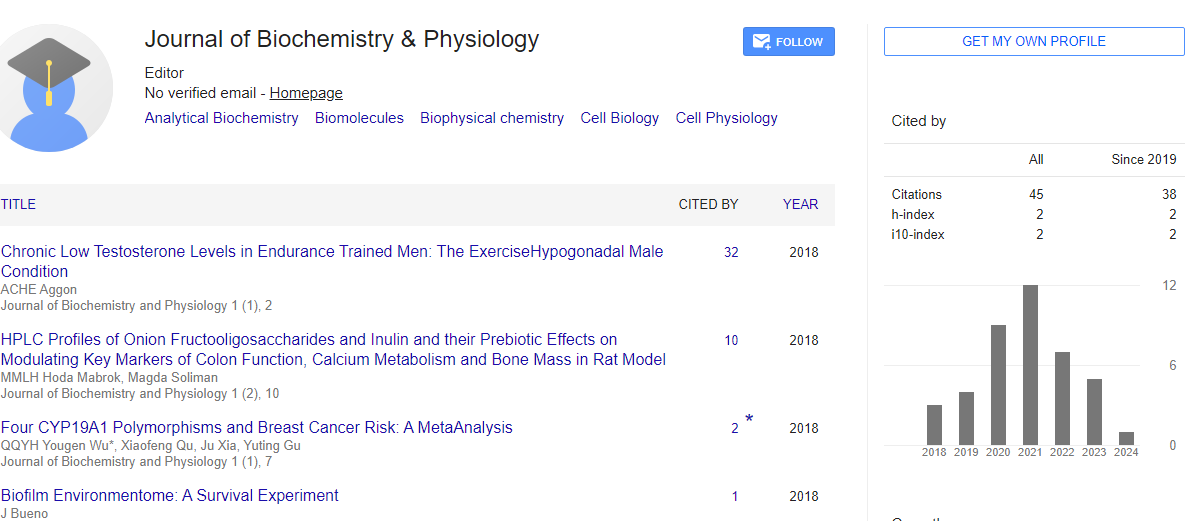Commentary, J Biochem Physiol Vol: 6 Issue: 2
Signal Transduction and Its Complex Intracellular Communication
Jian Yee*
1College of Food Science and Engineering, Shandong Agricultural University, Taian, China
*Corresponding Author: Jian Yee,
College of Food Science and Engineering,
Shandong Agricultural University, Taian, China
E-mail: jian@yee.edu.cn
Received date: 29 May, 2023, Manuscript No. JBPY-23-110492
Editor assigned date: 31 May, 2023, PreQC No. JBPY-23-110492 (PQ);
Reviewed date: 14 June, 2023, QC No. JBPY-23-110492;
Revised date: 21 June, 2023, Manuscript No. JBPY-23-110492 (R);
Published date: 28 June, 2023 DOI: 10.4172/jbpy.1000139.
Citation: Yee J (2023) Signal Transduction and Its Complex Intracellular Communication. J Biochem Physiol 6:2.
Abstract
Signal transduction pathways are intricate cellular mechanisms that allow organisms to sense and respond to their environment. This manuscript provides an in-depth exploration of signal transduction, covering its fundamental principles, major components, and diverse roles in cellular processes. It discusses key signaling molecules, transmembrane receptors, and downstream effectors, highlighting the significance of signal transduction in normal physiology and disease. Signal transduction forms the foundation of intercellular communication, enabling cells to coordinate their responses to external cues
Description
Signal transduction pathways are intricate cellular mechanisms that allow organisms to sense and respond to their environment. This manuscript provides an in-depth exploration of signal transduction, covering its fundamental principles, major components, and diverse roles in cellular processes. It discusses key signaling molecules, transmembrane receptors, and downstream effectors, highlighting the significance of signal transduction in normal physiology and disease. Signal transduction forms the foundation of intercellular communication, enabling cells to coordinate their responses to external cues.
It explores the mechanisms by which cells transmit and interpret signals, the impact on cellular behavior, and the broader implications for tissue function and homeostasis. Signal transduction is the process by which cells receive, interpret, and respond to external cues, ensuring dynamic adaptability and survival. This manuscript aims to elucidate the molecular intricacies of signal transduction pathways and their essential roles in maintaining cellular homeostasis.
Signal transmission and reception
Ligands and receptors: Extracellular ligands, such as hormones and growth factors, bind to cell surface receptors, initiating signal transmission.
Receptor activation: Ligand binding triggers conformational changes in receptors, often leading to phosphorylation events.
Intracellular messengers: Secondary messengers, like cyclic AMP (cAMP) and Inositol Trisphosphate (IP3), amplify and relay signals within the cell.
Intercellular signaling
Paracrine signaling: Cells release local signaling molecules that affect neighboring cells, influencing tissue development and homeostasis.
Endocrine signaling: Hormones are secreted into the bloodstream, conveying signals to distant target cells and organs.
Synaptic signaling: Neurons communicate through neurotransmitters at synapses, enabling rapid intercellular transmission.
Signal transduction pathways
G-Protein Coupled Receptors (GPCRs): These receptors activate G-proteins, which modulate downstream effectors, such as enzymes or ion channels.
Receptor Tyrosine Kinases (RTKs): Ligand binding leads to receptor dimerization and auto phosphorylation, triggering diverse cellular responses.
Intracellular receptors: Ligands that cross the cell membrane bind to intracellular receptors, influencing gene expression.
Gap junctions
Connexins: Gap junctions are channels composed of connexin proteins that allow direct communication between adjacent cells.
Ion and small molecule exchange: Gap junctions enable the passage of ions, metabolites, and small signaling molecules.
Coordinated cellular activities: Gap junction-mediated communication synchronizes cellular responses within tissues.
Exosome-mediated communication
Exosome biogenesis: Cells release exosomes, small membrane vesicles containing bioactive molecules, through endosomal pathways.
Cargo delivery: Exosomes transport proteins, nucleic acids, and lipids to recipient cells, influencing cellular behavior.
Intercellular signaling: Exosomes play roles in immune regulation, tissue repair, and disease progression.
Cell-to-cell signaling molecules
Cytokines and growth factors: Cells release cytokines and growth factors that act on neighboring cells to influence immune responses and tissue repair.
Neurotransmitters: Neurons communicate via neurotransmitters, affecting the activity of adjacent cells and tissues. Signaling molecules like morphogens establish concentration gradients to guide tissue patterning during development.
Crosstalk and integration
Cross-pathway interactions: Different signaling pathways often intersect and influence each other’s activity.
Signal integration: Cells process and integrate multiple signals to generate specific responses.
Cellular responses and adaptation
Gene expression regulation: Signal transduction pathways can lead to changes in gene transcription and protein synthesis.
Cell proliferation and differentiation: Signaling cascades control cell fate decisions, affecting tissue development and regeneration.
Apoptosis and cell survival: Signaling pathways can trigger programmed cell death or promote cell survival, maintaining tissue homeostasis.
Role in disease and therapeutic implications
Cancer metastasis: Altered intercellular communication can promote cancer cell invasion and metastasis.
Neurological disorders: Dysregulated signaling between neurons contributes to neurodegenerative diseases.
Targeted therapies: Manipulating intercellular communication offers opportunities for disease intervention.
Future directions and challenges
Systems-level understanding: Advancements in systems biology are crucial for comprehending the complexity of intercellular communication.
Therapeutic opportunities: Targeting specific signaling components holds potential for novel therapies and disease interventions.
Conclusion
Intercellular communication mediated by signal transduction is a cornerstone of multicellular life. The intricate web of communication mechanisms highlights the interconnectedness of cells within tissues and organs. Understanding and harnessing these pathways offer novel avenues for therapeutic interventions and our comprehension of complex biological systems.
 Spanish
Spanish  Chinese
Chinese  Russian
Russian  German
German  French
French  Japanese
Japanese  Portuguese
Portuguese  Hindi
Hindi 